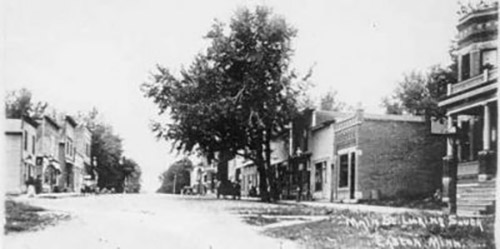The City of Easton
The site for the village of Easton was decided in the early 1870s when Colonel Thompson of Wells undertook the building of the Southern Minnesota Railroad from the Mississippi River west to Winnebago in Faribault County. Two factors were responsible for the exact location of the village. A building from Walnut Lake was to be hauled to the railroad workers camp about one half mile west of Easton, but because the ground was too muddy, it was left standing on the land now occupied by The Club.
That first building was later known as The Old Harness Shop and it became the first building in Easton. The other factor in developing the site was early trains had difficulty starting up their train loads on the rising land where the worker’s camp was located. The depot was built instead at the present community site of Easton.
The early history of Easton really begins with the settlement of Wesner’s Grove in Barber Township. Wesner’s Grove is located about one and one half miles west and three and one half miles south of the present site of Easton.


When the Southern Minnesota Railroad went north Wesner’s Grove ceased to exist. After the railroad line was in, several Illinois families heard about the rich soil along the railroad and bought farm sites near the present day Easton.
Conrad Ruff and Karl Rath both from Illinois each donated ten acres for the town site and the village was surveyed and staked in 1873. J.C. Easton of Chatfield, MN., a banker, was appointed Proprietor. By the end of that year, twelve buildings had been constructed or moved to the new city from Wesner’s Grove and Walnut Lake. Both of these towns have disappeared.
On March 9,1874, S.P. Mennison, Sec. of State, affixed the state seal to the Articles of Incorporation of the village of Easton. The plot was not filed for record with the Registrar of Deeds until March 14,1874. For a while the town was known as Lura Station in honor of the railroad site in Lura Township of Faribault county. The name was later changed to Easton to honor J.C. Easton. David Grice owned the first and only wagon shop in the village.
On July 4, 1874, the first formal civic celebration was held in the new village of Easton. By 1890 the population was 318. The annual Easton Community Calendar is available at the State Bank of Easton. It features historical photos from Easton’s past.
